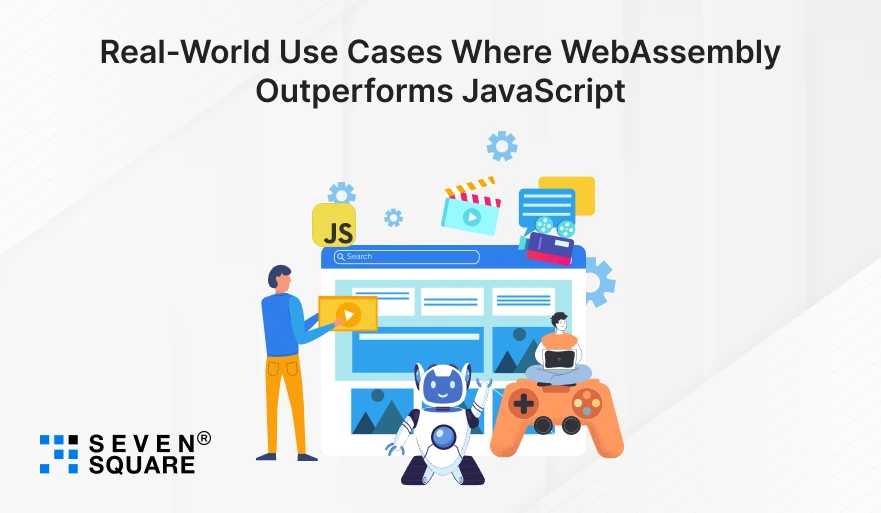Do you know that a 1-second delay in website loading can reduce conversions by over 20%?
Users expect web pages to load instantly, and if your website lags, your visitors are gone before it even finishes loading.
We’ve seen how website speed impacts user experience and business growth.
A faster website doesn’t just attract more users; it keeps them engaged longer and helps brands build trust.
That’s why modern developers and businesses are looking beyond traditional web technologies.
Enter WebAssembly (Wasm) is one of the best ways to run high-performance code directly in the browser. It’s changing how we build, optimize, & scale web applications.
Here you can learn how WebAssembly makes websites faster & more efficient, and why it’s becoming the preferred choice for developers who want top-tier performance.
What Is WebAssembly and How Does It Differ from JavaScript?
WebAssembly (or Wasm) is a powerful web technology that allows code written in languages like C, C++, or Rust to run inside web browsers at near-native speed.
It’s designed to make complex apps (like 3D games, video editors, or real-time data dashboards) perform faster than ever.
Now, when we talk about WebAssembly vs JavaScript, it’s about collaboration.
JavaScript has been the backbone of the web for decades, but it has its limits when handling heavy computations or graphics.
WebAssembly steps in where JavaScript struggles, delivering blazing-fast results for performance-critical tasks.
According to Wasm performance benchmarks, WebAssembly executes tasks up to 20x faster than JavaScript in some scenarios.
It loads precompiled binary code that runs almost as fast as native apps, without needing a plug-in or external software.
We integrate both, using JavaScript for flexibility and WebAssembly for speed, to create web apps that perform faster, load quicker, and deliver smoother experiences.
How WebAssembly Speeds Up Web Apps?
So, how does WebAssembly speed up web apps exactly?
The secret lies in its binary format and Ahead-of-Time (AOT) compilation.
Unlike JavaScript, which must be parsed and interpreted every time it runs, WebAssembly code is already compiled.
This means browsers can execute it immediately, saving precious milliseconds at every step. Here’s how it helps in real-world scenarios:
- Games & Graphics: WebAssembly allows web-based games to run with console-level speed and detail.
- Video Processing: WebAssembly handles media tasks like compression, editing, or rendering far faster than JavaScript.
- Data-Heavy Applications: Apps dealing with AI, simulations, or real-time analytics benefit from massive performance boosts.
This level of WebAssembly performance gives businesses a major advantage.
We use Wasm to help our clients build apps that load faster, run smoother, and handle more users without extra server cost.
When users experience a site that responds instantly without lag or stutter, it creates a lasting impression. That’s the magic of WebAssembly.
How Does WebAssembly Reduce Load Time for Websites?
If you’ve ever waited for a website to load, you know the frustration. WebAssembly fixes that by reducing both load time and execution time.
So, how does WebAssembly reduce load time for websites?
It comes down to three smart design choices:
- Smaller Binary Files: WebAssembly code is compact and optimized. It’s smaller in size compared to large JavaScript bundles, which means it downloads faster, even on slow networks.
- Simplifying Compilation: Modern browsers can start executing WebAssembly code while it’s still being downloaded, instead of waiting for the full file.
- Parallel Loading: Multiple threads can load and compile Wasm modules simultaneously, cutting down startup delays.
| Task | JavaScript | WebAssembly |
| Download | Slower (large file) | Faster (small binary) |
| Parse & Compile | Interpreted | Precompiled |
| Execution | Slower for complex tasks | Near-native speed |
This combination drastically reduces download and parse time, which means quicker page rendering and smoother user experiences.
We maximize these capabilities to help brands optimize their web apps for speed.
Whether it’s a gaming app, SaaS dashboard, or multimedia platform, WebAssembly helps us deliver next-level performance that users instantly notice.
Real-World Use Cases Where WebAssembly Outperforms JavaScript

WebAssembly use cases for web performance are everywhere. From gaming to AI, WebAssembly is making websites faster and more interactive than ever before.
Here are some examples where WebAssembly clearly outperforms JavaScript:
1. Online Games & Graphics Tools
- Tools like Unity, AutoCAD Web, and Figma rely on WebAssembly to deliver smooth, lag-free performance.
- Games that once needed a native app can now run in a browser because of Wasm’s near-native speed.
2. Image & Video Editors
- Complex editors like Photopea and web-based video platforms use WebAssembly to handle heavy tasks such as rendering, compression, and real-time previews, all directly in the browser.
3. AI & Machine Learning in Browsers
- AI models that once required backend servers can now run client-side.
- With WebAssembly, developers can execute AI/ML computations directly in browsers, cutting down latency and improving privacy.
These brands and industries trust WebAssembly for performance because it delivers faster processing, reduced lag, & an exceptional user experience.
Is WebAssembly Always Faster?
A common question we get from clients is “Is WebAssembly faster than JavaScript?”
The answer: Yes, mostly.
WebAssembly is best for tasks that involve heavy computation, like 3D rendering, video editing, or cryptography.
But when it comes to simple DOM operations (like updating a button or changing a color), JavaScript still performs better.
We don’t replace JavaScript entirely; instead, we use a hybrid approach.
- We use WebAssembly for performance-heavy logic, and
- JavaScript for UI interactions and real-time DOM updates.
This balanced combination delivers optimal web performance without overcomplicating the architecture.
So while WebAssembly is incredibly fast, knowing when and where to use it is the real key to success.
Why Businesses Should Care About WebAssembly?
From a business perspective, WebAssembly for business performance isn’t just a tech upgrade; it’s a strategic advantage.
Here’s why forward-thinking brands are adopting it:
- Faster Apps Means Better Retention: Faster load times mean happier users. Studies show that speed directly improves engagement and conversions.
- Reduced Server Costs: Since WebAssembly can handle more processing on the client side, it reduces backend load and cloud costs.
- Competitive Edge with New Tech Adoption: Companies adopting WebAssembly early position themselves as innovation leaders in their space.
We help businesses integrate WebAssembly into their systems to improve both user experience and ROI.
The future of web performance is all about combining speed, scalability, and security, and WebAssembly delivers all three.
How to Integrate WebAssembly into Your Project?

We are breaking it into a few steps of WebAssembly performance optimization for React apps or any modern web project.
Here’s a simplified guide from our development team:
1. Choose a Language
- You can write WebAssembly modules in C, C++, Rust, Go, or Blazor (C#).
- For most modern projects, Rust is the top choice due to its safety and performance.
2. Compile to WebAssembly
- Use tools like Emscripten or wasm-pack to compile your code into .wasm format.
- For example, developers can learn how to compile Rust to WebAssembly to achieve native-level speed in web apps.
3. Integrate with Frontend
- Import the compiled .wasm module into your React, Next.js, or Vue app.
- This helps you run high-speed code while keeping your familiar frontend framework.
4. Optimize & Test
- Run benchmarks and tweak performance based on Wasm performance benchmarks. Use profiling tools to identify bottlenecks.
We help businesses integrate WebAssembly smoothly into their web ecosystem for faster, secure, and scalable performance.
Want to Integrate WebAssembly in Your Website? Contact Us Now!
WebAssembly is the Secret Factor for Web Speed
WebAssembly makes websites faster and more efficient by bringing native performance to the web.
From reducing load times to handling complex computations, it’s changing how the internet works.
For businesses, this means better speed, happier users, & stronger results.
We’re already using WebAssembly to build futuristic web apps according to the client’s requirements.
FAQs
- WebAssembly (Wasm) runs precompiled binary code, which executes at near-native speed, unlike JavaScript, which is interpreted.
- It reduces load time, executes code faster, and handles complex tasks efficiently.
- Yes, WebAssembly easily integrates with frameworks like React, Next.js, and Vue for performance-heavy tasks.
- Yes, its compact binary size and fast execution make it ideal for mobile browsers.